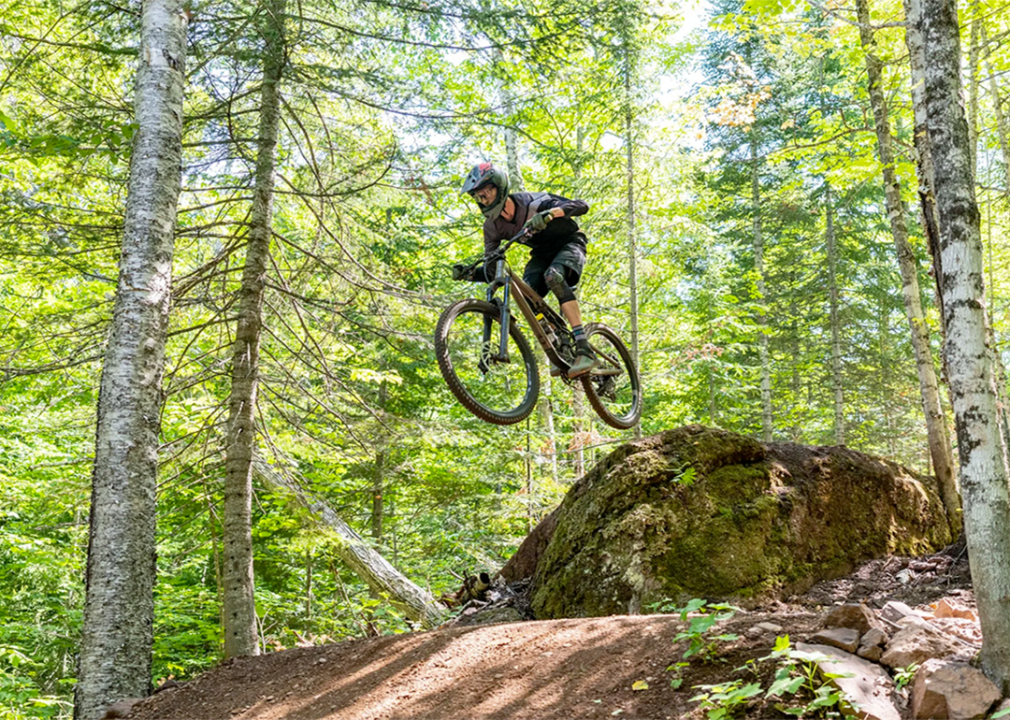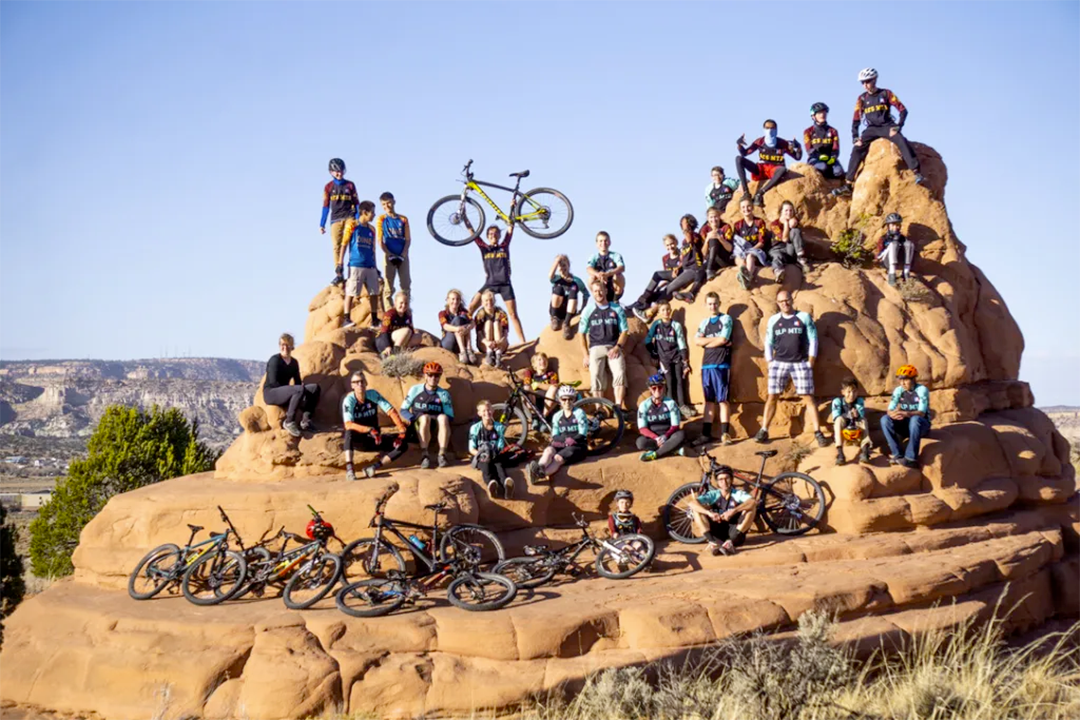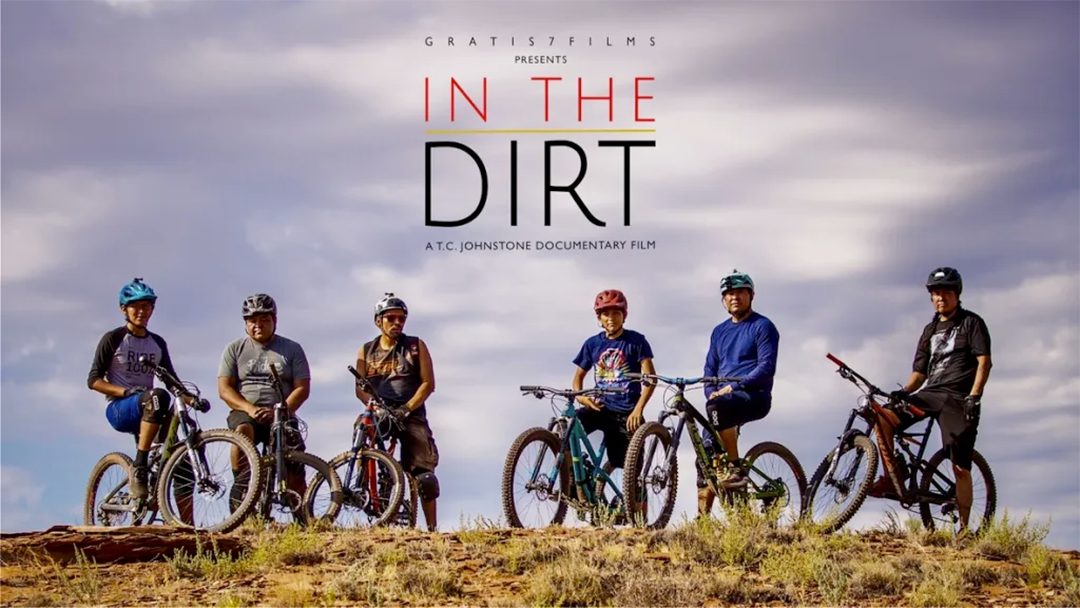Blazing trails in the mountains

Nathan Miller // Copper Harbor Trails Club
Blazing trails in the mountains
Mountain biker going off a jump on a dirt track with trees in the background.
Mountain bikers ride for the thrill. The joy of racing downhill. The feeling of choosing the best path, hugging the ground, catching some air. The deep satisfaction of being connected to the natural world by navigating its challenges and experiencing its beauty.
“Mountain biking is unique in the world of trails,” writes Dave Wiens, International Mountain Biking Association Executive Director, on the organization’s website. “For the mountain biker, the trail is the experience. No other trail user feels, relishes, and appreciates every undulation and nuance of a well-crafted trail that has been purposefully and creatively planned, designed and built for the bike.”
The Daily Yonder reports that, increasingly, communities across the country are putting serious investments of money, time, and effort into constructing these kinds of well-crafted mountain biking trail systems.
The Rising Popularity of Pedaling Outdoors
Like all outdoor recreation pursuits, mountain biking was growing steadily in the 2010s. Participation exploded during the pandemic, when science showed that being outside was the best way to prevent spread and outdoor recreation was one of the best ways to support mental health. According to Chris Perkins with the Outdoor Recreation Roundtable, millions more people flocked to outdoor destinations than ever before.
Anyone who tried to purchase a bike in 2021 discovered that demand outstripped supply. According to a Sports and Fitness Industry Association report, nine million people rode a bicycle off-road in 2022, compared to only 6.9 million in 2007. And though the unique parameters of the pandemic have ended, the draw of outdoor recreation has not. Perkins said that while official numbers aren’t yet out for 2023, he has seen data from numerous organizations that indicate it was a record-breaking year.
The outdoor recreation industry is gaining recognition as a significant economic driver, especially in rural areas looking to diversify their economic base. According to the U.S. Bureau of Economic Analysis (BEA), the outdoor recreation economy in 2020 generated $1.1 trillion and supported five million jobs. From 2021-2022, the outdoor recreation economy grew 2.5 times faster than the U.S. economy as a whole.
Mountain biking is riding that wave. The BEA reports that in 2022, mountain biking had an economic country-wide impact of $2.07 billion. In Colorado alone, a 2018 study funded by the Outdoor Alliance on the economic impact of mountain biking tourism in Grand Mesa, Uncompahgre, and Gunnison national forests showed over 150,000 visits a year. Seventy percent of cyclists were from outside the surrounding region, and annual spending by mountain bikers was $24 million.
All this attention and use means that mountain biking trail systems are undergoing an evolution. Originally constructed by scrappy volunteer club members with shoestring budgets, trails are now professionally designed and constructed. The role of club members has shifted to maintenance, fundraising, and networking.
Networking is crucial. Rural places are uniquely poised to provide epic trail adventures. Generally, a destination-level system has 25+ miles of interconnected trails that incorporate a range of difficulty levels and technical challenges and capture some of the unique natural and cultural features of the location. Their development usually requires collaborative work with multiple landowners and jurisdictions. Perkins said the ORR’s work with local communities has shown the number one prerequisite for the development of an outdoor recreation ecosystem is local grassroots advocates.
Another important piece is funding. A mile of trail can cost $45,000. Perkins is hopeful about two federal funding sources, the Rural Outdoor Investment Act and the Travel, Tourism, and Outdoor portion of the American Rescue Plan. “We need to invest in outdoor recreation infrastructure at the same level as the record-breaking visitations so the resources last for generations to come,” he said in an interview.
The following conversations explore with local leaders in three rural towns their reasons for, and experiences of, developing mountain biking trail systems, and what they bring to their communities.
![]()

Courtesy of Silver Stallion Bicycle & Coffee Works
A Natural Experience: Copper Harbor Trails Club
Group photo of Silver Stallion competition team posed on a rock formation.
The town of Copper Harbor, Michigan, pop. 121, sits at the northernmost tip of the Upper Peninsula and declares itself the furthest town in the contiguous U.S. from an interstate (about five hours). Originally built for copper mining, it has been an outdoor-centered tourism destination for more than 100 years. The Copper Harbor Trails Club started constructing mountain biking trails here in the 1990s, making them one of the pioneers of the sport in the Midwest. The terrain, with substantial hills, waterfalls, and Lake Superior, is a big draw.
“Biking here is a truly wild experience,” said Nathan Miller, Executive Director of the Copper Harbor Bike Club, in an interview. “You can bike ten miles in the middle of the wilderness and pop out at a scenic vista of Lake Superior.”
Copper Harbor has been identified as a destination-worthy trail system by the International Mountain Biking Association since 2012. As one of the first real trail systems developed in the Midwest, it has developed a sizable reputation. One third of visitors to town plan mountain biking as one of their activities. Local businesses sponsor the club programs because the quality-of-life benefits of accessible outdoor recreation keeps their employees wanting to live in the area.
But recently, the town’s popularity has strained the community’s infrastructure. Already busy, Copper Harbor saw a big spike in visitation during COVID-19, and not just by cyclists. Visitors using the main mountain biking trailhead, located near the fire station and post office in the center of town, kept locals from accessing these basic services. The bike club and community are working on solutions, like constructing trail-specific campgrounds outside of downtown that incorporate connector trails so visitors can access the community on two wheels.
The influx of cyclists of all levels also laid bare weaknesses in trail emergency services. While mountain biking is generally considered safe, a couple of major injuries happened in a short span of time. First aid care relied on volunteer first responders. The incidents made leaders realize that many community servants were not equipped to attempt a five-mile adventure into a remote setting to rescue someone who is lost or injured. The club is in the process of recruiting and training a bike patrol that can provide emergency care in the backcountry.
The accidents also threatened the status of the trail system. The public land organization that owned the trails closed them, then sold them, without consulting the biking community. Fortunately, the private purchaser of the system reopened it.
As the bike club works through these growing pains, it hasn’t lost sight of the special place and sport it stewards. Each summer, Copper Harbor hosts a trail event over Labor Day weekend. Riders gather in the park each evening for live music and socializing. During the last two events, the northern lights appeared in the night sky and people were awed.
“That is something you can only have in Copper Harbor,” said Miller. “Ride around on great trails all day and then have a life-altering experience you will never forget.”
Community-focused Development: Bailey’s Trail System, Athens County
Cycling has a long history in this piece of Appalachian Ohio. The Athens Bicycling Club formed in the 1970s, and in the early days the group hand-built miles of mountain biking trails that crisscross two state parks and city property. A paved 22-mile bikeway, the Hockhocking Adena, runs beside the Hocking River and connects several communities.
In 2016, the club envisioned its most ambitious plan to date: developing 88 miles of world-class professionally constructed mountain biking trails across a 9,000-acre, primarily unused tract of the Wayne National Forest. The completed system will connect three small towns struggling to rebuild after a long history of extractive industry. The access point in the small town of Chauncey is the community park, which is situated on a reclaimed coal mine.
“We saw Bailey’s as a catalyst for a changing economy,” said Jessie Powers, Executive Director of the Outdoor Recreation Council of Appalachia (ORCA), in an interview. “We want to rewrite the script about what the benefits could be for rural communities.”
The effort was spearheaded by a multistakeholder coalition that included the bike club, city and county governments, local nonprofits, the national forest, business owners, and the county health department. Their goal was to have the trail system benefit local people as much as possible. Trailheads intentionally placed in these three communities provide easy trail access for locals and enhanced opportunities for economic development.
The coalition formed ORCA as an umbrella organization to secure impact investment funds for the trail development. Using a pay-for-success structure, ORCA set up social enterprises that benefit the community and enhance the trail system as a destination. For example, they operate the only bike rental business in a 100-mile radius and sell merchandise designed and created by local artists. To remove barriers for small businesses to open near the community trailheads, ORCA plans include a 5,000-foot commercial facility that will be available for lease by local entrepreneurs.
Even before completion, the trail system is making a big difference in these communities. In 2021, with one trailhead and 26 miles of trails, the system generated $3.6 million dollars of direct impact for the county, according to an Ohio University impact analysis.
Powers believes the area has great potential as a destination. Just adjacent to Athens County is Hocking Hills, an internationally celebrated destination that welcomes four million visitors a year to enjoy its forested landscape and geologic wonders. The terrain of Athens County is very similar.
“ORCA was created to deliver the Bailey’s Trail System but the mission is much larger,” she said. “We want to help Appalachian Ohio understand the opportunity outdoor recreation provides rural communities. It has economic, social, environmental, and health benefits.”

Courtesy of Silver Stallion Bicycle & Coffee Works // Gratis 7 Films
A Health and Wellness Initiative: Navajo Nation
Key art for In the Dirt film documentary depicting six mountain bikers and their bikes against a cloudy sky.
When former professional mountain biker Scott Nydam moved to Gallup, New Mexico, he was introduced to the cycling community on the neighboring Navajo Nation. He knew he wanted to support and encourage their efforts, and decided to address the lack of a bicycle shop in the area. He founded Silver Stallion Bicycle & Coffee Works, a nonprofit providing education in bicycle mechanics and apprenticeship in specialty coffee for youth.
As Nydam set to work, he realized the needs were bigger than his nonprofit mission statement. Developing mountain biking on the Nation requires material capital (bikes, trails), intellectual capital (riding and maintenance skills) and social capital (coaches, mentors). He sees himself as part of a conglomerate of people trying to bring together all of those pieces.
Trails were part of the plan, but not the first goal. There is no precedence for them on the Navajo Nation, where land ownership is complex. Seven years ago, developing a ribbon of trail through the landscape required the same permission process as a gas pipeline.
“The reservation system doesn’t really work, especially for community-driven initiatives like trails,” said Nydam in an interview.
Still, Nydam saw the radical potential. He knows first-hand the benefits of riding: a new relationship to the environment, improved physical health, promotion of mental health through focus and agency. The approach of biking leaders was to position the effort as a community wellness initiative. They work closely with the Indian Health Service to promote cycling among the Nation’s youth and families.
“Riders have to pedal their own bikes and make their own decisions,” said Nydam. “We are trying to add mountain biking to the quiver of health promotions.”
With the support of Indian Health Service, public schools, and cycling advocates, Silver Stallion established an array of youth ridership programs. Thirteen schools now have PE class programs. Two hundred ninety-two middle schoolers participated in five afterschool programs – more than 1/5 of the participating schools’ populations. The nonprofit provides free bikes for kids who are somehow involved in their efforts.
The programs have created trust with schools, teachers, and social workers. While Nydam used to feel like he had to “sell” mountain biking, now he is responding to schools and communities who have seen how their kids are thriving. After two years of the program, kids were getting bored with dirt roads and wanted real trails. An engineered plan for 18.7 miles of trails is (slowly) working its way through the necessary bureaucracy. Meanwhile, leaders are developing trails on school property in concert with administrators and communities.
“This region is vast and epic and beautiful,” said Nydam. “But trails and land-use decisions need to fall in the boundaries of self-determination. It is enough for outdoor recreation to exist on Navajo, for Navajo.”
This story was produced by The Daily Yonder and reviewed and distributed by Stacker Media.